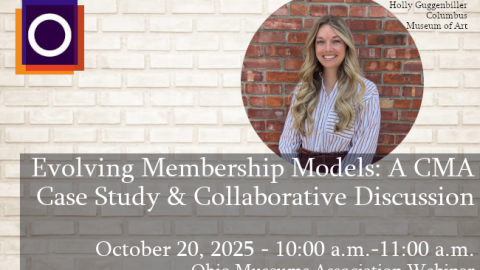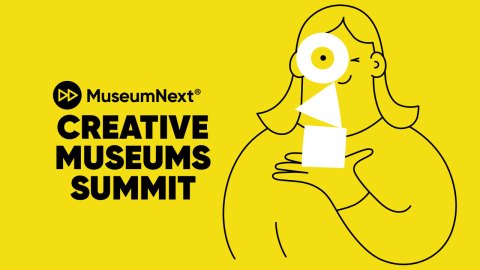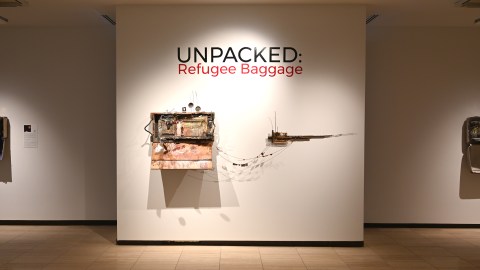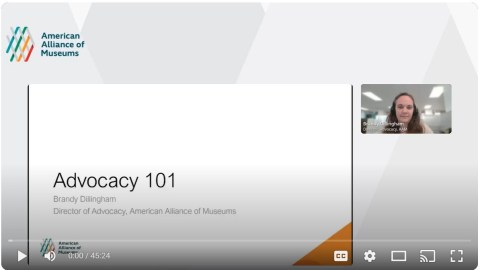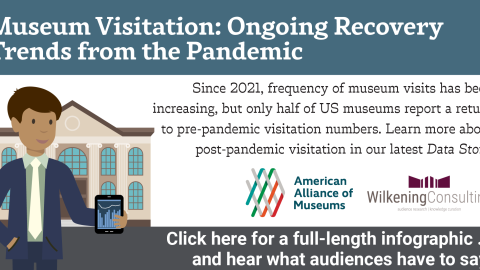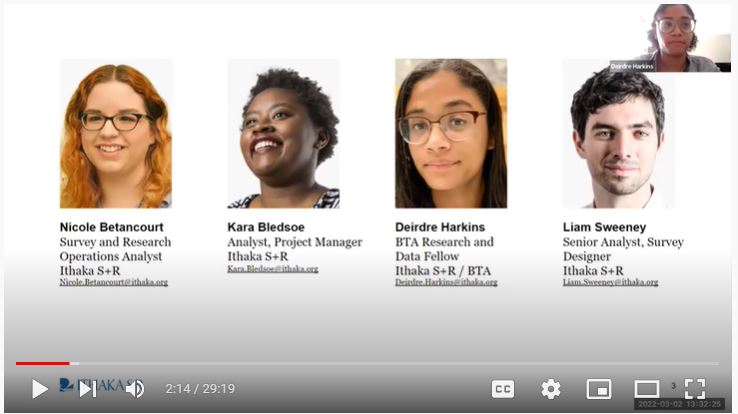
Cycle 3 of the Art Museum Staff Demographic Survey – funded by The Andrew W. Mellon Foundation – opened to art museums across North America on Monday, February 7. To support the data collection process, Ithaka S+R staff used part of this session to walk through the instructions for the Survey and discussed frequently asked questions. The session ended with a Q&A for attendees to ask questions of their own that address specific concerns for their institutions. If you have not received the link to the Survey, please contact Deirdre Harkins (Deirdre.Harkins@ithaka.org) at your earliest convenience. Click here to review the slides from this presentation.
Presenters
- Kara Bledsoe
Analyst, Project Manager
Ithaka S+R
Kara.Bledsoe@ithaka.org - Deirdre Harkins
BTA Research and Data Fellow
Ithaka S+R / Black Trustee Alliance for Art Museums
Deirdre.Harkins@ithaka.org - Liam Sweeney
Senior Analyst
Ithaka S+R
Liam.Sweeney@ithaka.org
Transcript:
Kara Bledsoe: Hi, everyone. We’re going to go ahead and get started in the interest of time. My name is Kara Bledsoe. We’ll do some more introductions in a second, but first we want to start with a few ground rules. So this session is being recorded. All of you are muted by default and you don’t have the option for video. We welcome you to use the Q&A feature to let us know any questions, comments, concerns that you have throughout the presentation and I’ll be monitoring that. We’ll leave some time for Q&A’s at the end. The recording of this session with captions and the transcript as well will be made available to you guys by email, I think in the next week or so. And we’ll also have it available on the Ithaka S+R website and the AAM website. If we don’t get to any of your concerns, anything that you wanted us to talk about, please feel free to email us at any time. Our contact information is on the next slide.
Like I said, my name is Kara Bledsoe. I’m an Analyst at Ithaka S+R and I’m the project manager for Cycle 3 of the Art Museum Staff Demographic Survey. I wanted to take a second to acknowledge our colleague, Nicole Betancourt, who isn’t here with us to present, but is still a core part of our project team. She’s the one who helps us program our surveys into our platform and then she will be involved with any troubleshooting that we have if you guys have issues with the platform moving forward. And Deirdre, why don’t you next and then Liam.
Deirdre Harkins: Sure. Hi, everyone. My name’s Deirdre Harkins and I’m a research and Data Fellow through Black Trustee Alliance for Art Museums working at Ithaka S+R.
Liam Sweeney: Hi, everyone, Liam Sweeney. I’m a Senior Analyst at Ithaka S+R.
Kara Bledsoe: All righty. Next we want to go into some acknowledgements. So we have aspirations for the Staff Demographic Survey to reach the widest possible range of art museums. And we have you guys to thank for contributing your work to the study. We’re also grateful to the Andrew W. Mellon Foundation for being our partner in this project for almost the last 10 years. We want to also extend thanks to the Association of Art Museum Directors and the American Alliance of Museums for helping us distribute this survey to hundreds of museums in their membership and another special thank you to the American Alliance of Museums for allowing us to use their platform for the webinar.
And now I’ll give just some context for what my colleagues will go over about our project. We are in the third iteration of the survey, very exciting and some things are new for us in this iteration. We have updated options for the job categories that better reflect what we’ve seen as trends in the field. We are being intentional again about including a more diverse mix of museums. And we are working on providing some additional resources to support you guys in submitting your data, this webinar included. I also want to spend some time talking about our data collection process. So we’ve used a very similar process throughout cycle one and cycle two and it’s really a important for our ongoing analysis to make sure that that process is retained. We do our best to only request data that museums typically already collect whether through your HR processes or otherwise. We want to make sure that our data can align with other data sets for a more robust analysis in our reporting like the US Census.
And we want to make sure that we can locate trend lines over time. So with this being the third iteration of the survey, there’s a lot of potential for us to see how things have fluctuated over almost the last decade. And we need to respect the process in order to make those concrete claims. We also have some future work that’s happening right now and will be released. And that’s coming up in our pipeline. The second cycle of the art museum director survey is opening very soon so be on the lookout for that. We have an ongoing study of diversity, equity and inclusion in museums and we’ll have a publication related to that coming up in the next couple of months. And then we are working with the Black Trustee Alliance for Art Museums that Deirdre mentioned on the Art Museum Trustee Survey that closed in January and we’ll have some publications coming out in the next couple of months about that.
And then just before my colleagues get into more detail about the data process, we wanted to spend some time defining a couple of terms that we use very frequently. The first is a variable. So essentially the variable is a column and the data set and these different columns, these different variables help us to break up the data into useful categories for analysis. Then we have categories and categories just add specificity to each variable and it’s the categories that allow us to make those connections to other data sets. And we’ll talk about that a bit later. Now I want to pass it to my colleagues, Liam and Deirdre to talk more about the data collection process.
Liam Sweeney: Great, thanks Kara. So yeah, I’m just going to walk us through getting the data submission process going. So I imagine on this call, there may be some museum directors. There may be some HR directors or HR staff. So not knowing exactly where you are sliding into this process. I’m just going to give a high level overview. The museum director should have received an email like the one on the left that has a little bit of text explaining the project and a link to Qualtrics landing page. Qualtrics is a survey platform we’re using. And this landing page has some high level text that explains what we’re asking from the museum and it also has a few other resources. So next slide.
So one of those resources is a supplementary instruction sheet. If you select this link, it’ll download the spreadsheet instructions to your browser. This I think is indicating a Chrome browser with Firefox. It may generate a popup, but in any case, it’ll be in your downloads folder of your computer. And these spreadsheet instructions offer detailed step by step guide to how to complete the spreadsheet. Then lower on the landing page, there is a link to download the spreadsheet template. And again if you click on it, that’ll automatically download the spreadsheet to your computer.
The way we’re tracking participation in this survey is through submission of the data over email. So once you’ve emailed the spreadsheet to Deirdre Harkins, you’ll be marked as having participated. So the finished button really doesn’t mean anything to us. It’s really submitting the data that is the relevant thing for participation, so you can ignore that. You should have a link that you can refresh to access the landing page. Again, even if you click finished, but if that’s not the case, if you’re having problems with the link, just reach out to us and we’ll make sure to sort that out. And now I’m just going to pass it to my colleague Deirdre to go into more detail about filling out the spreadsheet template.
Deirdre Harkins: Thanks, Liam. So I’m going to go over how to add the data to the spreadsheet. So after opening the file, you’ll see a blank spreadsheet with two tabs on the bottom. You’ll be entering your data in the template tab. If you click any of the cells and columns B-L, an arrow will appear on the right indicating a dropdown list with available categories to choose from. Next slide, please. Larger museums may upload their data from their HR systems and adjust the formatting as needed. In the second tab labeled “Lists”, all of the categories for each variable are listed. Something that might be useful to use is the “Find and Replace,” feature available in Excel or Google sheets for those with differences in data uploaded from their HR systems. For example, you may have Caucasian listed under Race while we have White in our template. Using the “Find and Replace” feature would make that an easy fix. Each employee will have their own row in the spreadsheet. And we ask that you please include all current museum employees, but please do not provide their names as any personally identifiable information will be deleted.
Now I’m going to go over each specific column. So in Column A, please provide the employee’s “Job Title” at the museum. And in column B, please group the employee’s Job Title to the corresponding job type categories that we have provided. For example, someone listed as an art educator in Column A should fall under the education category in Column B. We have a table in our FAQ section coming up later to give a better idea of how this works. In Column C, please choose the “EEO Category” that corresponds to the employee’s position. If that data is not already tracked at your museum, we have provided a table as well in our FAQ section, as well as any instruction document.
Column D asks about “Exemption Status”. So please select whether the employee is exempt or non-exempt. Column E asks about “Employment Type” whether they are a regular employee, meaning that they work all year without a fixed term, a temporary employee, which means they’re on a fixed term or as a contractor as they’re hired of your contractor agreement, as well as paid and unpaid interns. If you don’t track demographic information for interns, please include them as “Employees Anyway”, through the “Employment Type” variable and can choose to decline to state for the other columns.
Column F refers to whether the employee is full-time or part-time. G asks about the employee’s highest level of education. It’s common that this is not tracked by museums. So please select “Decline State” for that. Column H asks about race. We’ve used the same categories that the US Census uses. And in column I please select whether the employee is Hispanic or Latino. Column J refers to gender identity, K to protected veteran status and L to disability status. If veteran or disability status is not tracked by the museum, please select Decline to State. Column M asks for the employee’s “Year of Birth” and N asks “Year of Hire.” For this we ask that you please provide the initial that the employee was hired regardless of their current position.
Next slide please. And once you’re finished filling in the data, please save the spreadsheet with the following format, with the name of your museum first underscore 2022 underscore Staff Demographics. This just makes it easier for us to track the responses. And when you are finished with that, please send the spreadsheet to me, Deirdre Harkins at Deirdre.Harkins@ithaka.org with the subject line, name of Your Museum 2022 Staff Demographics. And I say it again, please put your museum name first, as it just makes it easier to track the emails coming in daily. Passing it back over to Liam now.
Liam Sweeney: Thanks, Deirdre. So now we’re going to go into just some frequently asked questions. These are things that have come up in the past cycles and that we anticipate folks may have questions about. So for the purposes of this project, we developed a definition for “Art museum”. We’re not considering this a canonical or like icon definition. This is really just for our purposes for scoping the project. So we’re defining art museum here as a non-profit institution that is a primary focus on collecting conserving and exhibiting fine art, not including libraries, archives, historical houses and for-profit galleries, but we do include kunsthalles which are non-collecting art museums and feel free to reach out to us directly if you have any questions about that. I think Kara, you were going to take this one, yeah?
Kara Bledsoe: Yeah. I have so many buttons that I’m pressing. Apologies for that little lag. So like we mentioned before, we’re being really intentional about having a more diverse mix of museums involved in this project and one of the ways that we’re doing that is through geographic area. So we are working with our partners to disseminate the survey to hundreds of museums across North America, including Canada and its host nations, Mexico and the United States of America. And we include Hawaii, Puerto Rico and other US territories in Commonwealth with the United States. If your museum is located in a country that’s not listed here, for example, you guys are in the Caribbean. Contact us and we’ll help you work out whether or not you’re eligible.
Liam Sweeney: Great. And so as an incentive to participate, we’ve done this in the past. We offer the first 200 participating museums, a complimentary institutional report dashboard, really that contextualizes your museum’s demographics in relation to the field. It’s possible depending on resources, depending on our bandwidth, that we may be able to extend that to more museums, but we’ve guaranteed the first 200 museums, one of these reports and we’ll be deploying those after the publication and after the survey portion closes.
We also guarantee the confidentiality and privacy of the data that we collect. We’ve been, as Kara mentioned, doing this since 2014. Sometimes folks send in data sets that have sensitive or confidential personally identifiable information in the spreadsheet. We delete that as soon as we get it. We ask that you please don’t send data other than the fields that we’re requesting. We will be publishing the data set in the ICPSR database at University of Michigan, specifically with an NEA funded database called the National Archive for Data on Arts and Culture, NADAC.
But we are publishing it in a way that makes it both impossible to reidentify both a museum and any individuals from the dataset. So it’s sort of a more aggregated public dataset that’s published. So every time we do this study, we’re receiving hundreds of spreadsheets from museums. It adds a lot of a burden on our team when many of those, the conventions used to submit this data, are inconsistent. So we just ask to conform to the standards that we provided. And now I’m going to turn this over to my colleague, Deidre to go through a few more slides.
Deirdre Harkins: Thanks, Liam. As mentioned earlier, we provided this chart with common job titles to help match job titles in Column A, to EEO job categories in column C. So for example, a role that would fit in the officials and administrator’s category would be something like a collections manager. Next slide, please. And then that was just a continuation on that slide. And to quickly go over the employment type categories in Column E and common job title examples, we have a chart similar to those of the previous slides with common job title examples with corresponding employment types. For example, a seasonal art handler would typically fit in the temporary employee category. Next slide, please.
And just to go over Column I, ethnicity once more, we have followed the format of the US Census as we’ve said before in this and that we have separated race and ethnicity into different columns. However, these two variables will be combined in our final analysis, which is common practice. Some tips are that if you’re a museum collects Hispanic and Latinos status as a racial category for those employees, please select “Decline to State for Race in column H and select “Yes” in Column I for ethnicity, Hispanic or Latino. And the same goes for if your records say that an employee is Hispanic or Latino, but you do not have race recorded. Again, select “Decline to State” in Column H and select “Yes” in Column I.
Kara Bledsoe: So now we’re going to just take some questions. Thanks for adding some things to the chat. Oh, so we had Deborah Cullen-Morales from Mellon who’s working with us on the Mellon side join today. Hi, Deborah. Thank you for being here. We have a question from another Deborah. She’s asking, including unpaid interns, what should we use for exemption? So, Liam, could you speak to how you would classify unpaid interns?
Liam Sweeney: Yeah. Thanks. For unpaid interns I would say if the museum isn’t already tracking their status as exempt or non-exempt, then I’d ask you just use decline to state for that category.
Kara Bledsoe: Right. Someone asked us to slow down while we were speaking. Apologies. Fortunately, this is being recorded. So hopefully you can go back to that and reference and please do contact us if you have any other questions. Let’s see. Yes. So someone is asking if the recording will be available. Yes. We are going to make the recording available to you. AAM has agreed to have this professionally captioned and transcribed. So the recording will be available as well, a transcription. Okay. Someone’s asking if we can get the FAQs. Yes, we will share these slides with AAM. And there’s also an instruction document that is accessible through the landing page for the survey.
So we’ll make sure that these slides and the link to the instruction document are available to you guys. The recording will be available likely within the week, but we’ll have to confirm that for you. We want to have it available by next week at the earliest. All righty. If there’s no other questions I’m not seeing any others. We’re happy to end a bit early today. Oh, let’s see. Okay. Someone’s asking about where the link is to the survey. Deidre, could you share with them about that?
Deirdre Harkins: Sure. So you should have received an email probably within this past week. And the link to the survey is in that email, which if you click on the link, it takes you to the landing page and then the landing page has the instructions for exactly how to fill it out. It’s not a traditional survey in the sense. So that’s why we have the instructions on how to fill in the spreadsheet. But yeah. Good question.
Kara Bledsoe: Alrighty. We have another question from someone, oh, someone who wasn’t here. Yes. This will be recorded and you will have access to the recording AAM. We’ll send it out to all of the people who registered. And we have a question asking if it’s possible for two individuals to work on the spreadsheet in different areas. So I’m taking that to mean that there’s a single spreadsheet and you’re both adding to it. I’ll let Liam and Deirdre also add to this. My first thought is that yes, it’s possible for that. If you want to turn this into like a Google sheets or like you want to put it on one drive or something where you guys can share it together, but what gets sense to us needs to be an Excel spreadsheet. Liam, did you want to add to that?
Liam Sweeney: Yeah. Yeah. We’re agnostic about how you complete the survey, as long as it conforms to the categories that we’re providing, but what you download is a CSV or is an Excel spreadsheet. And so like Kara was saying, if you put that in a shared environment where two people can work on it together, that’s fine, but that’s not how we’ve designed it. So it is just a single file that downloads to your computer.
Kara Bledsoe: Thanks, Sam. We have another question here. The email that we sent with the survey probably went to the director who has been gone. Is there any way, besides the email to get a link? Yes, you can contact us using the information provided in this presentation. So the slides will be made available with our contact information. You can also reach out directly to Deirdre. Her email address is Deirdre.Harkins@ithaca.org and we can send you the link. Let’s see. Are there any other questions? All right. Well, we can go ahead and close out. Oh, let’s see. What is the subject name of the email? Okay. Let’s go back to that slide. Deirdre, did you want to go over that again?
Deirdre Harkins: Sure. So the subject name would be the name of your museum and 2022 staff demographics.
Liam Sweeney: I think maybe Naomi means the email that came in to her into the inbox.
Deirdre Harkins: The name of the… It should be Art Museum Staff Demographics Survey.
Liam Sweeney: I think we have, if we go back in the slide, I think actually have a version of that email in the slide deck. Maybe forward there. Yeah. Art Museum Staff Demographic Survey.
Kara Bledsoe: Are there any other questions? There’s someone asking-
Liam Sweeney: Right. Yeah. I think that there was a reminder message and there was an invitation. So Mellon Foundation or Museum Demographic Survey, that should be the invitation message. So searching on those two in your inbox should get them. But just to reiterate, the email, went to museum directors and then we’re expecting in many cases, the director to forward it to their HR staff. So if you’re an HR staff on here who didn’t receive anything about this, you can ask your director. And if the director says, “We didn’t get an email about this,” then just reach out to us and we can make sure to resolve that.
Kara Bledsoe: Thanks, Liam. Someone’s asking if they can get the slides with the job titles and job types, those tables a little sooner. Yes. We’ll work with AAM to get the slides prepared for you guys as soon as we can. So someone’s asking, can we, yes, we’re going to do our best. The slides are already ready. So we’ll probably turn into a PDF and pass it along to our colleagues at AAM. And hopefully they can get that out as soon as they can. Any other questions? All right, then. So we can go ahead and close out. Thank you all for attending. Thanks to AAM for the platform. And hopefully we’ll have submissions from all of you guys very soon. Take care.
Liam Sweeney: Thanks. Bye.

